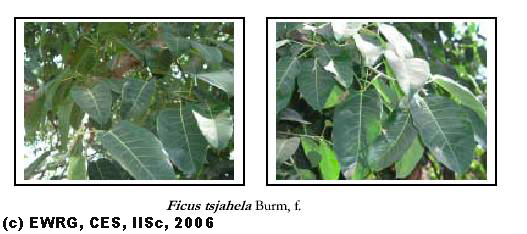
| Back | Next |
Figs are trees, shrubs or woody climbers. Compound, fleshy fruits in this genus are popularly known as ‘figs', the term is also often used to refer to the trees. All of them exude a milky sap when cut. Many species are epiphytes and are known as strangler figs. Some fig species are functionally unisexual.
About 750 species of figs are primarily distributed in the tropical forests. India has nearly 60 species of figs, half of which are unisexual. In north-western India, only 5 species occur, one of them being unisexual. Of the 17 species inhabiting southern India, only 4 are unisexual but out of 41 species in north-eastern India, 27 are unisexual, many being shared with southeast Asia.
Geographically, figs are poor as disperses and invaders, due to dependence on wasps for pollination and birds for dispersal. Birds such as barbets, hornbills, parakeets, bulbuls, mynas, orioles, crows depends on figs for survival during their lifetime. Besides, figs are more prone to local extinction as the erratic climatic fluctuations may lead to reproductive failures and wasp extinction. Consequently, endemicity amongst figs is lower than in other genera. Only 4 (16%) of the 27 species of figs occur exclusively in Western Ghats, while more than 33% of the total 800 tree species of the Western Ghats are endemic. In India, figs are distributed all over the lowlands, below 1000 or rarely 2000 m. Rajasthan hosts just 5 species, while north-eastern India shelters 41 species. Western Ghats harbour 27 species while the rest of the peninsula 17. Andaman and Nicobar islands host 12 species.
Ficus tsjahela Burm, f. Vern., Bilibasuri, Boviya, Kappubasari, Karibasuri; San.: Kapithana
Large trees. Leaves alternate, leaves not caudate, leaf blade ovate-lanceolate, abruptly acuminate, rounded – truncate at base, glabrous, shining, coriaceous, with 3-5 basal nerves. Petiole 3-5 cm long articulate to the lamina. Lateral nerves 8-12 pairs. Basal bracts 3, distinct, bifid, patent. Figs 2-6 fascicled on tubercles in the axils of leaves or fallen leaves, sessile, globular, pale yellow when ripe.

List of Visitors found on the Ficus tsjahela Burm, f. tree
Sl. No. |
Bird Visitors |
Mammal Visitors |
1 |
Whitethroated Ground Thrush |
Hanuman Langur (troop of 12 individuals) |
2 |
Green Pigeon |
|
3 |
Koel |
|
4 |
Small Green Barbet |
|
5 |
Golden Oriole (Mature & Immature) |
|
6 |
House Crow |
|
7 |
Tree Pie |
|
8 |
Blackheaded Cuckoo Shrike |
|
9 |
Blackheaded Oriole |
Fl.: January to April
Distribution: South India, Sri Lanka.
Leaves poisonous to livestock.